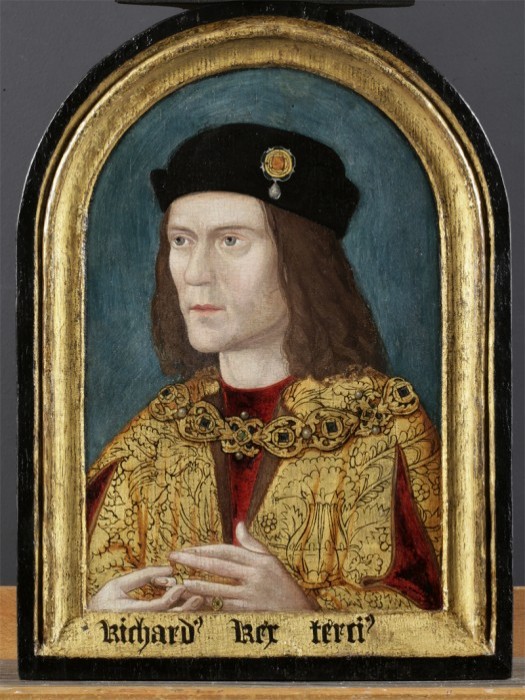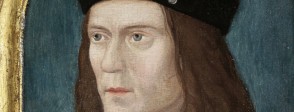
Reproduced by permission of the Society of Antiquaries of London (© Society of Antiquaries of London)
The appearance of the king
This portrait of Richard III is likely to be a 16th century copy of a lost original and is the earliest surviving version of a prototype made during the king’s reign, between 1483 and 1485. Copyist painters would have made versions of the prototype original for individuals or organisations who wished to display a portrait of the king in their home or premises.
Richard’s character is conveyed by a focused, determined expression and his kingly status and bearing are emphasised by his clothing and jewellery. He wears a robe made from cloth-of-gold lined with fur - both expensive, imported materials. The impression is heightened by his red velvet tunic and black velvet hat and his gold collar, studded with pearls and diamonds. The jewel on his hat is in the form of a rose, probably referring to the House of York to which he belonged. He wears a ring on the third finger of his left hand, which at the time was a symbol of love and faithfulness and associated with marriage. He is shown toying with the ring perhaps to indicate his readiness to remarry after the death of his wife Anne in March 1485.
What is striking about the portrait is that the viewer sees none of the deformity one has come to expect from other representations of Richard and, most notoriously, from his depiction by Shakespeare – there is no more than a slight unevenness of the shoulders. The results of analysis of the skeletal remains excavated in Leicester in 2012 and now confirmed as those of Richard, confirm several features of the portrait. The portrait’s slender fingers and fine facial features match well with the skeleton’s skull and limbs; DNA analysis indicates that the eye and hair colour in the portrait is correct; the curvature of the skeleton’s spine would have resulted in a raised right shoulder, though the degree of unevenness is not clear; there is no indication in the bones of a withered arm and nothing to prevent an active lifestyle.
Appearance and interpretations
Other portraits of Richard, both those from the early 1500s such as the one in the Royal Collection and another belonging to the Society of Antiquaries, and those dating from the later 1500s and early 1600s show the king with one shoulder significantly higher than the other, often with a large ‘hunched back’ and often with a twisted or deformed hand. His expression is frequently interpreted as taut, glaring and ruthless. It is generally agreed that these differences, along with the descriptions of Richard by, among others, Sir Thomas More and Shakespeare, are attributable to the Tudor desire to justify the usurpation of the throne by Henry VII by depicting Richard as a monstrous tyrant – a tactic which had its basis in a wider philosophical belief at the time that physical appearance reflected inner character.
Nowadays we have little time for the notion of a relationship between the physical and the moral, but the issue of Richard’s appearance still seems to be an element in the debate about how we should assess him as a monarch. The Richard III Society, as devoted supporters of Richard, seek to present the positive policies and actions of his two-year reign which range from acts of personal and public piety to the benefits he brought to the north of England, from his military prowess to legislation establishing the principle of bail and from his abolition of royal benevolences to measures to prevent fraud.
The history in appearance
Short of a miracle, it will never be possible to ascertain for certain what Richard III looked like in life. It is this very point which makes the study of his portraits worthwhile, in that all we can actually study is the representation of the king and this leads in more interesting historical directions. Whether or not this painting shows Richard accurately, as the earliest reflection of an original portrait from the king’s reign it gets us as close as possible to how Richard wanted himself to be seen. The changes to the expression of the portrait that were revealed by cleaning in 2007 confirm that at some stage after its making, someone else may have wanted Richard to be seen differently. The same motivation can also be detected in, for example, the Royal Collection portrait, where Richard’s shoulder was raised significantly compared with the original and, of course, in the many other later portraits.
A further dimension is introduced by the other early portrait of Richard in the Society of Antiquaries, which dates from between AD 1523 and 1555, well into the Tudor period. This one depicts Richard holding a broken sword which may to symbolise a ‘broken’ sword of state, and therefore the destruction of his kingship and, as might be expected, the painting also shows him with a clearly raised left shoulder and a deformed left hand. X-ray examination of the painting has shown that the shoulder had originally been raised even higher, but was over-painted to reduce its size. This was probably done in the eighteenth century when Richard’s reputation underwent a revival. The study of the representation of Richard rather than the search for his real appearance allows us to explore how narratives change through time as contemporary conditions and political environments call for a different interpretation of the past.
More information
Society of Antiquaries of London
Online catalogue of an exhibition with entries for both portraits and a portrait of Edward IV.
http://makinghistory.sal.org.uk/page.php?cat=2
Portrait of Richard III from the Royal Collection
http://www.royalcollection.org.uk/collection/403436/richard-iii-1452-85
Royal Shakespeare Company: Richard III
Including a synopsis, contextual information and teachers pack and images of different productions.
http://www.rsc.org.uk/explore/shakespeare/plays/richard-iii/
National Portrait Gallery article about portraits of English kings and queens
http://www.npg.org.uk/research/programmes/making-art-in-tudor-britain/case-studies/picturing-history-a-portrait-set-of-early-english-kings-and-queens.php
The Richard III Society articles about Richard III’s life and reign
http://www.richardiii.net/2_1_0_richardiii.php#
The Richard III Society articles about Richard III’s appearance
http://www.richardiii.net/2_4_0_riii_appearance.php#appearance
Richard III: A Study in Medical Misrepresentation
A detailed discussion of the portraits and Richard’s medical conditions.
http://www.ncbi.nlm.nih.gov/pmc/articles/PMC2726816/
Article discussing the verbal descriptions of Richard
http://www.the-tls.co.uk/tls/public/article1208757.ece
University of Leicester Richard III Project
A wealth of information and resources about the excavation, the findings, Richard and the historical context.
http://www.le.ac.uk/richardiii/index.html
University of York website about Richard III
http://richardiii-ipup.org.uk/
More information
-
Society of Antiquaries of London
Online catalogue of an exhibition with entries for both portraits and a portrait of Edward IV.
Source: sal.org.uk
-
Portrait of Richard III from the Royal Collection
Source: royalcollection.org.uk
-
Royal Shakespeare Company: Richard III
Including a synopsis, contextual information and teachers pack and images of different productions.
Source: rsc.org.uk
-
National Portrait Gallery article about portraits of English kings and queens
Source: npg.org.uk
-
The Richard III Society articles about Richard III’s life and reign
Source: richardiii.net
-
The Richard III Society articles about Richard III’s appearance
Source: richardiii.net
-
Richard III: A Study in Medical Misrepresentation
A detailed discussion of the portraits and Richard’s medical conditions.
Source: nih.gov
-
Article discussing the verbal descriptions of Richard
Source: tls.co.uk
-
University of Leicester Richard III Project
A wealth of information and resources about the excavation, the findings, Richard and the historical context.
Source: le.ac.uk
-
University of York website about Richard III
Source: richardiii-ipup.org.uk/


